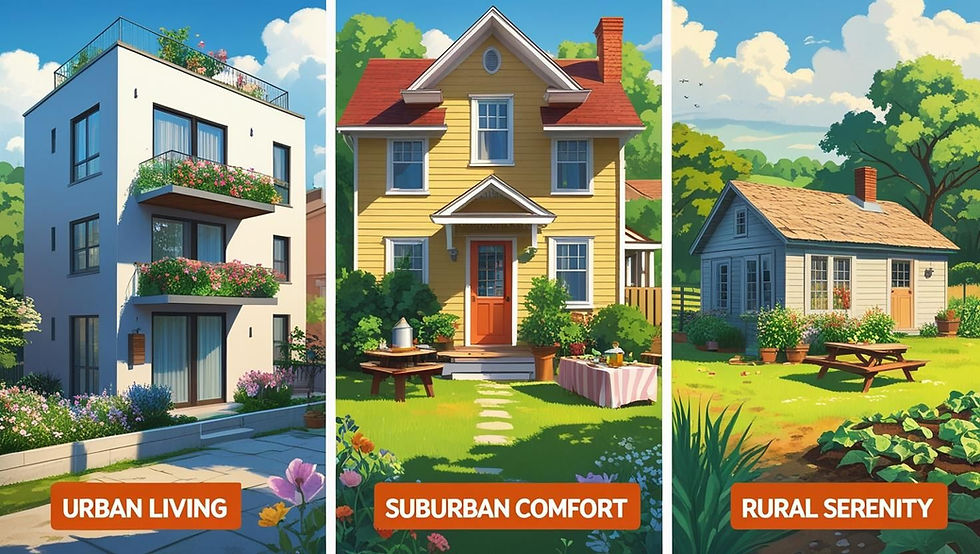How to Build a Life Focused on Self-Sustainability
- Jul 20
- 3 min read
Let’s be honest... today’s world feels a little bonkers! Between rising prices, constant noise, and mystery ingredients in store-bought food, more folks are craving a lifestyle that’s slower, more grounded, and built on their own terms. That’s where self-sustainability steps in.
It’s not about living in a hut with no Wi-Fi (unless that’s your jam). It’s about taking practical steps toward providing for yourself, reducing reliance on unstable systems, and aligning daily life with your values.
What Even Is Self-Sustainability?
Self-sustainability means meeting your basic needs, like food, water, and energy, without leaning heavily on external systems. It’s independence, but with compost and chickens.
This could mean:
Growing your own produce
Preserving food for the off-season
Using renewable energy
Raising animals or insects (hey there, Luna Roaches!)
Finding creative ways to reuse, trade, and simplify
Whether you’re tending a tiny windowsill garden or building a fully functioning homestead, it all counts.
How to Start (Without Getting Overwhelmed)

Here’s how to begin without burning out:
Start Small: A pot of herbs. A compost bucket. A solar light. Every change matters.
Grow Something You’ll Actually Eat: Tomatoes, salad greens, or fresh herbs = immediate gratification.
Preserve the Bounty: When the garden over-delivers, learn to can, dehydrate, or ferment.
Cut Down Waste: Compost scraps, reduce plastic, and use cloth instead of paper where you can.
Use Less Energy: Efficient appliances, turning off lights, and adding solar when possible all help.
The journey isn’t about perfection; it’s about progress.
How Much Space Do You Need?

Space | What You Can Do |
Windowsill/Apartment | Grow herbs, start compost, sprout seeds |
Suburban Lot | Veggie beds, fruit trees, small livestock like chickens |
1–5 Acres | Large gardens, livestock, bees, rainwater, renewable energy |
Our own place started small and grew with us... your setup can evolve too. The key? Make the most of what you’ve got.
Water Wisdom: Keep It Flowing
Sustainability and water go hand-in-hand:
Catch Rainwater: A simple barrel can water your whole garden.
Reuse Gray Water: Use sink or tub water (safely!) to irrigate.
Plant Native or Drought-Resistant Crops: Save on watering.
Drip Irrigation: Precision hydration that your plants and water bill will love.
Power to the People (That’s You!)

Here’s how to keep the lights on, sustainably:
Solar Panels: Start small and scale as you go.
Wind Power: A mini turbine can supplement your needs.
Biomass Heating: Wood stoves and burners using scrap can be game changers.
Smart Habits: Unplug, switch off, and use efficient gear.
Find Your People
Going it alone gets lonely. Thankfully, self-sustainability and community go together like fresh eggs and sourdough:
Join a Co-op: Share seeds, knowledge, and bulk buys.
Barter with Neighbors: Trade zucchini for soap or eggs for jam.
Share Skills: Everyone has something to teach ...and learn!
Volunteer Locally: Gardens, food pantries, and ag events need hands!
Real Talk: Peaceful Beekeeping & Golden Rewards
On our homestead, we have two Flow Hives, and the experience has been nothing short of magical. Our very first harvest gave us over 40 pounds of honey: without smoke, stress, or a single grumpy bee.
Here’s what we love:
It’s peaceful...for us and the bees.
The viewing windows let us monitor activity without opening the hive.
Harvesting is as simple as turning a key and watching the honey flow.
The important part is to still perform regular inspections. Flow Hives aren’t a "set-it-and-forget-it tool" they’re part of a broader care routine. Checking brood health, watching for mites, and keeping the colony happy is still essential. Thanks to this system though, our beekeeping now feels like a meditative ritual, one that fits right into our values of mindful, low-intervention care.
Embracing the Journey

Self-sustainability is more than a checklist. It’s a lifestyle built on resilience, joy, trial and error, and a lot of dirt under your fingernails. Some days you’re sipping homegrown herbal tea on your porch. Other days, the Livestock escapes and eats your newly planted carrots. It’s all part of the adventure. And trust us - it’s worth it!



Comments